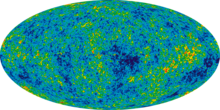Our website is made possible by displaying online advertisements to our visitors.
Please consider supporting us by disabling your ad blocker.
Big Bang nucleosynthesis
| Part of a series on |
| Physical cosmology |
|---|
 |
In physical cosmology, Big Bang nucleosynthesis (also known as primordial nucleosynthesis, and abbreviated as BBN)[1] is a model for the production of light nuclei, deuterium, 3He, 4He, 7Li, between 0.01s and 200s in the lifetime of the universe.[2] The model uses a combination of thermodynamic arguments and results from equations for the expansion of the universe to define a changing temperature and density, then analyzes the rates of nuclear reactions at these temperatures and densities to predict the nuclear abundance ratios. Refined models agree very well with observations with the exception of the abundance of 7Li. The model is one of the key concepts in standard cosmology.
Elements heavier than lithium are thought to have been created later in the life of the Universe by stellar nucleosynthesis, through the formation, evolution and death of stars.
- ^ Cite error: The named reference
RPPwas invoked but never defined (see the help page). - ^ Schramm, David N.; Turner, Michael S. (1998-01-01). "Big-bang nucleosynthesis enters the precision era". Reviews of Modern Physics. 70 (1): 303–318. arXiv:astro-ph/9706069. doi:10.1103/RevModPhys.70.303.
Previous Page Next Page
تخليق نووي بدائي Arabic Nucleosíntesi primordial Catalan Prvotní nukleosyntéza Czech Big Bang-nukleosyntese Danish Primordiale Nukleosynthese German Nucleosíntesis primordial Spanish هستهزایی مهبانگ FA Alkuräjähdyksen ydinsynteesi Finnish Nucléosynthèse primordiale French סינתזה גרעינית קדמונית HE


